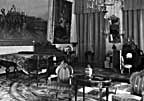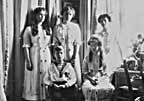News and Announcements - Studies of suspected Russian royal remains continues - expert
Studies of suspected Russian royal remains continues - expert
Yekaterinburg, Russia, June 18, Interfax - Laboratories in the United States and Austria have finished identification investigations of the suspected remains of the son and one of the daughters of last Russian tsar Nicholas II but more studies are needed, a senior Russian forensic expert said.
"I can say that some of the tests have been finished and some not, and apparently there will be some more investigations. For instance, an investigation that involves spotting areas in DNA that are responsible for the development of hemophilia [a disease Nicholas' son, Alexey, suffered from], has not been finished yet," Nikolay Nevolin, head of the Sverdlovsk Regional Bureau of Forensic Medicine, told Interfax. "There will most likely be more investigations," he said.
In July 2007, fragments of two bodies with marks of a violent death were found buried by the side of a country road near Yekaterinburg, the city in the Urals where a Bolshevik firing squad executed Nicholas, his family and some members of their retinue in July 1918.
Genetic investigation of the fragments, suspected to be what remains of the bodies of Alexis and Maria, was taken up by the Sverdlovsk Bureau of Forensic Medicine, a lab in Moscow, a U.S. Armed Forces DNA identification lab, a genetic lab at the University of Massachusetts, and a lab in Innsbruck, Austria.
"I can say that some of the tests have been finished and some not, and apparently there will be some more investigations. For instance, an investigation that involves spotting areas in DNA that are responsible for the development of hemophilia [a disease Nicholas' son, Alexey, suffered from], has not been finished yet," Nikolay Nevolin, head of the Sverdlovsk Regional Bureau of Forensic Medicine, told Interfax. "There will most likely be more investigations," he said.
In July 2007, fragments of two bodies with marks of a violent death were found buried by the side of a country road near Yekaterinburg, the city in the Urals where a Bolshevik firing squad executed Nicholas, his family and some members of their retinue in July 1918.
Genetic investigation of the fragments, suspected to be what remains of the bodies of Alexis and Maria, was taken up by the Sverdlovsk Bureau of Forensic Medicine, a lab in Moscow, a U.S. Armed Forces DNA identification lab, a genetic lab at the University of Massachusetts, and a lab in Innsbruck, Austria.





 Imperial Bedroom
Imperial Bedroom Portrait Hall
Portrait Hall Mauve Room
Mauve Room Maple Room
Maple Room Aleksey's Bedroom
Aleksey's Bedroom Nicholas's Study
Nicholas's Study Aleksey's Playroom
Aleksey's Playroom Formal Reception
Formal Reception Balcony View
Balcony View Aleksey- Balcony
Aleksey- Balcony Children-Mauve
Children-Mauve Nicholas's Bathroom
Nicholas's Bathroom Alexandra- Mauve
Alexandra- Mauve Nicholas's Reception
Nicholas's Reception Tsarskoe Selo Map
Tsarskoe Selo Map